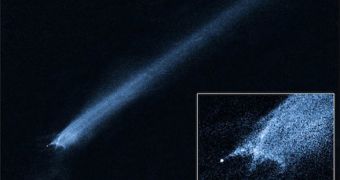According to a new scientific investigation, the key ingredients for the development of life may in fact appear in space, aboard meteorites and other wandering space rock. This conclusion was drawn after experts discovered basic molecules on a meteorite, in a place where they shouldn't have existed.
It goes without saying that life as we know it couldn't have appeared in space. However, the molecules that eventually grew to such degrees of complexity so as to underlie life can survive in outer space.
Recently, while analyzing a meteorite, investigators discovered amino acids on its surface. These molecules are the main building blocks of proteins, which in turn combine to enable every possible mechanism and chemical reaction taking place in an organism.
The space object was recovered in northern Sudan, where it crashed after flying through the coldness of space for millions of years. Experts who analyzed it say that it was created in a violent crash.
The discovery of amino-acids on space rocks is just the latests in a string of discoveries that redefines Earth's past history. It could be that the elements that enabled life to develop here were indeed brought by comets and meteorites, as first suggested many years ago.
The reason why amino-acids are important is because they can combine in millions of different ways to produce proteins and enzymes. There are 20 amino-acids, and they can be arranged similarly to how letters can be combined to create words.
“Finding them in this type of meteorite suggests that there is more than one way to make amino acids in space, which increases the chance for finding life elsewhere in the Universe,” says Daniel Glavin.
“This meteorite formed when two asteroids collided,” explains the scientist, who holds an appointment with the NASA Goddard Space Flight Center (GSFC), in Greenbelt, Maryland.
“The shock of the collision heated it to more than 2,000 degrees Fahrenheit [1,093 degrees Celsius], hot enough that all complex organic molecules like amino acids should have been destroyed, but we found them anyway,” he adds.
In the past, investigators have discovered amino-acids in the comet Wild 2, as well as in a small number of carbon-rich meteorites. But the team that investigated the meteorite 2008 TC3 had no expectations to find the molecules hidden within.
Samples from the space rock were divided between the GSFC and a lab at the Scripps Institution of Oceanography (SIO), a facility based at the University of California in San Diego (UCSD).
“Our analyses confirm those obtained at Goddard,” says that leader of the SIO study, Jeffrey Bada
“Previously, we thought the simplest way to make amino acids in an asteroid was at cooler temperatures in the presence of liquid water. This meteorite suggests there's another way involving reactions in gases as a very hot asteroid cools down,” Glavin concludes.
Details of the new work were published in the December 15 issue of the esteemed journal Meteoritics and Planetary Science, Space reports.

 14 DAY TRIAL //
14 DAY TRIAL //